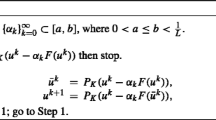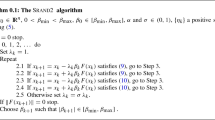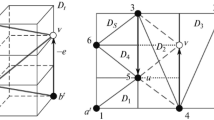Abstract
We deal with a recently proposed method of Chubanov for solving linear homogeneous systems with positive variables. Our first aim is to show that the performance of this method can be improved by a slight modification of Chubanov’s so-called Basic Procedure. In theory this results in at least the same decrease of the merit function used by Chubanov, but both in theory and in practice the decrease may be much faster. Theoretical evidence for the speed-up follows from a lemma, whereas some numerical experiments provide convincing computational evidence. We also present a complete, somewhat simplified analysis of Chubanov’s Main Algorithm, thereby including also some numerical experiments.
Access this chapter
Tax calculation will be finalised at checkout
Purchases are for personal use only
Similar content being viewed by others
References
Broyden, C.G.: A simple algebraic proof of Farkas’s lemma and related theorems. Optim. Methods Softw. 8(3/4), 185–199 (1998)
Chubanov, S.: A polynomial relaxation-type algorithm for linear programming. http://www.optimization-online.org/DB_FILE/2011/02/2915.pdf (2012)
Chubanov, S.: A strongly polynomial algorithm for linear systems having a binary solution. Math. Program. Ser. A 134(2), 533–570 (2012)
Chubanov, S.: A polynomial projection algorithm for linear programming. http://www.optimization-online.org/DB_FILE/2013/07/3948.pdf (2013)
Dantzig, G.B.: An ε-precise feasible solution to a linear program with a convexity constraint in 1∕ε 2 iterations, independent of problem size. Technical Report SOL 92-5, Systems Optimization Laboratory, Department of Operations Research, Stanford University, Stanford, Oct 1992
Edmonds, J.: Systems of distinct representatives and linear algebra. J. Res. Nat. Bur. Stand. Sect. B 71B, 241–245 (1967)
Epelman, M., Freund, R.M.: Condition number complexity of an elementary algorithm for computing a reliable solution of a conic linear system. Math. Program. Ser. A 88(3), 451–485 (2000)
Golub, G.H., Van Loan, C.F.: Matrix Computations, 2nd edn. Johns Hopkins University Press, Baltimore (1989)
Khachiyan, L.G.: A polynomial algorithm in linear programming. Dokl. Akad. Nauk SSSR 244, 1093–1096 (1979). Translated into English in Sov. Math. Dokl. 20, 191–194
Li, D., Terlaky, T.: The duality between the perceptron algorithm and the Von Neumann algorithm. In: Zukuaga, L., Terlaky, T. (eds.) Modelling and Optimization: Theory and Applications, pp. 113–136. Springer Science+Business, New York (2013)
Pólik, I.: Addendum to the Sedumi User Guide. Version 1.1. http://www.sedumi.ie.lehigh.edu/wp-content/sedumi-downloads/SeDuMi_Guide_11.pdf (2005)
Renegar, J.: A polynomial-time algorithm, based on Newton’s method, for linear programming. Math. Program. 40, 59–93 (1988)
Schrijver, A.: Theory of Linear and Integer Programming. Wiley, New York (1986)
Stiemke, E.: Über positive Lösungen homogener linearer Gleichungen. Math. Ann. 76, 340–342 (1915)
Sturm, J.F.: Using Sedumi 1.02, a Matlab toolbox for optimization over symmetric cones. http://www.plato.asu.edu/ftp/usrguide.pdf (2001)
Acknowledgements
We thankfully acknowledge valuable comments of an anonymous referee that not only made the paper more readable but also helped to reduce the time for computing the matrix P A . Thanks are also due to Tomonari Kitahara (Tokyo Inst. of Technology) for the correction of some typos in an earlier version.
Author information
Authors and Affiliations
Corresponding author
Editor information
Editors and Affiliations
Rights and permissions
Copyright information
© 2015 Springer International Publishing Switzerland
About this paper
Cite this paper
Roos, K. (2015). On Chubanov’s Method for Solving a Homogeneous Inequality System. In: Al-Baali, M., Grandinetti, L., Purnama, A. (eds) Numerical Analysis and Optimization. Springer Proceedings in Mathematics & Statistics, vol 134. Springer, Cham. https://doi.org/10.1007/978-3-319-17689-5_13
Download citation
DOI: https://doi.org/10.1007/978-3-319-17689-5_13
Publisher Name: Springer, Cham
Print ISBN: 978-3-319-17688-8
Online ISBN: 978-3-319-17689-5
eBook Packages: Mathematics and StatisticsMathematics and Statistics (R0)




